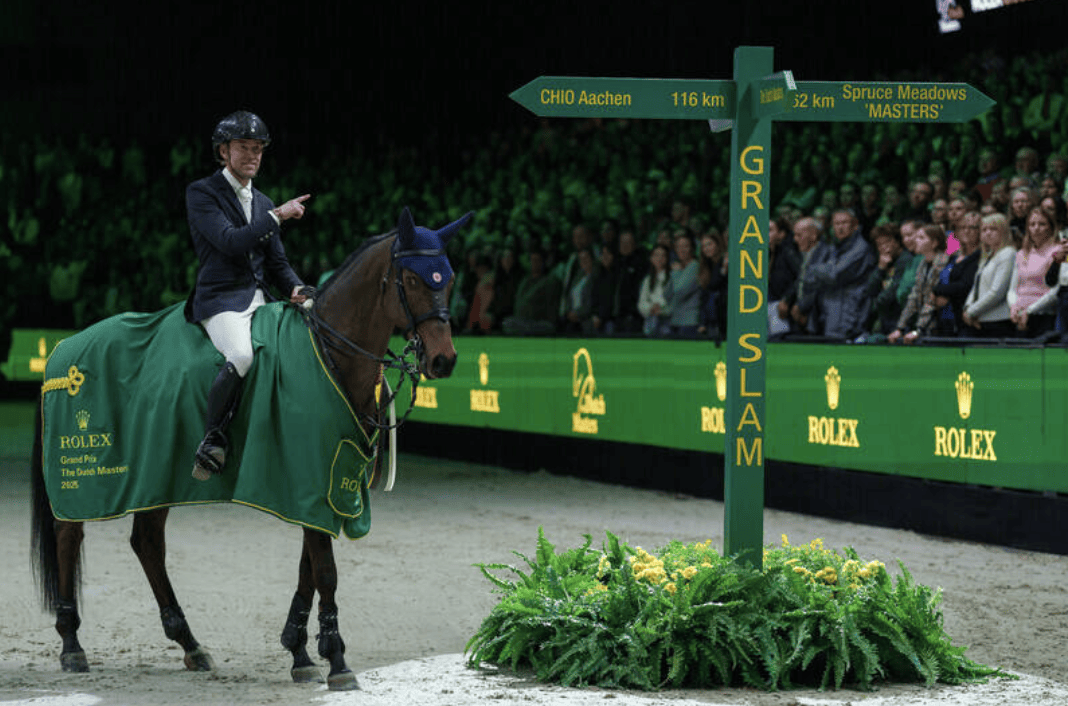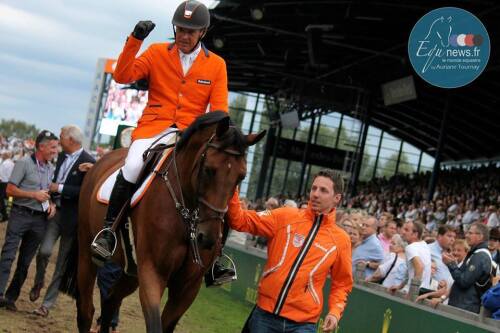The thirteen-year-old SF gelding Cayman Jolly Jumper (f: Hickstead), bred by Nathalie Chevalier, has earlier this year not only won the Rolex Grand Prix at The Dutch Masters, but also impressed during the Saut Hermès! “Cayman Jolly Jumper was no coincidence” – The Breeding Story Behind a Top Showjumper. As breeder Chevalier puts it: “Jus de Pomme was my inspiration!”
Nathalie Chevalier sees a lot of Cayman Jolly Jumper in his dam, Riva de Pleville, a mare by Quaprice Bois Margot. When she saw Riva free-jump as a three-year-old, she was immediately sold: her quality stood out. That moment marked the beginning of Chevalier’s breeding journey, with Riva as the foundation.
As Riva turned out to be even more talented than expected, Chevalier opted for embryo transfer. She registered her own stud name, “Jolly Jumper,” and selected Hickstead MVD as the sire. In 2012, Cayman Jolly Jumper was born—Riva’s first foal via embryo transfer. His success didn’t go unnoticed. A second foal followed in 2014: Evora Jolly Jumper (by Qlassic Bois Margot). Evora performed strongly as a five-year-old in Fontainebleau but was sold just before the final. She later jumped successfully up to 1.40m–1.50m in Canada with Matthew Sampson, until an injury ended her sporting career prematurely.
Inspired by Jus de Pomme
“In 2001, I bought Orientale DB from Guido Bruyninx. She is the dam of Cayman’s sire line,” Chevalier explains. “When I bought her, she was already in foal to Kannan—and that foal would become Riva. I really enjoyed working with Orientale. She was eventually sold at the Fences auction in 2004.”
A great admirer of Jus de Pomme, Chevalier believed that combining his influence with Quaprice Bois Margot would be ideal. This led to the birth of Riva de Pleville via embryo transfer, as well as R de Pleville (by Orlando) in 2005.
Riva later went under saddle with Bruno Garez, but her small stature and fiery temperament made her less suitable for top-level sport. She was sold and became a broodmare—a decision that ultimately led to the birth of Cayman.
Kannan: An Unexpected Global Star
Orientale DB produced a Kannan foal at Valérie Allix’s stables—a breeding arranged by Guido Bruyninx. Although Bruyninx played a key role in Kannan’s rise as a top sire, he admits to barely remembering this particular mare, something he says oddly fits the unpredictable nature of Kannan’s story.
“I bought Kannan at the end of his four-year-old year, on the advice of a Dutchman,” Bruyninx recalls. “It was an expensive purchase, so I only bought half at first—which already worried my wife. When I later bought the whole horse, she became even more concerned.”
Bruyninx rode Kannan himself for a year, then sold half to François Mathy Sr. They kept him together until Bruyninx became Belgian champion with the stallion as a seven-year-old. After that, François Mathy Jr. took him to the Sunshine Tour, where Kannan was sold to Alexandrine Hécart of Haras de la Roque in France. There, he built a stellar career both as a sport horse and as a breeding stallion.
“Kannan was truly unique,” says Bruyninx. “I regret that I haven’t found a stallion of his caliber again in 30 years. Success always involves a bit of luck. No one could’ve predicted Kannan’s global career. It’s strange to have been part of the background of a horse like Cayman Jolly Jumper and barely remember it now.”
Anglo-Arabian Blood as a Foundation
Orientale DB was bred at Haras du Hazoy. Nicole Bouilliart doesn’t remember the mare in detail, but she outlines the background of her breeding program: “At the time, I bought La Bise du Thil from her breeder Jacques Pennet, originally for sport. Later, we used her for breeding.”
Together with Nelson Pessoa, Bouilliart co-owned the stallion Feinschnitt van de Richter, who nearly fifty years ago formed the cornerstone of her breeding operation. She mainly worked with Anglo-Arabian and Thoroughbred mares, firmly believing that speed and blood were essential for success in sport.
Out of La Bise du Thil, she bred an excellent daughter by Feinschnitt van de Richter, whose descendants are now competing internationally. It’s remarkable how someone—often without even realizing it—can play a role in the creation of a horse like Cayman Jolly Jumper. Perhaps that’s the essence of breeding: you don’t always see the result right away, but your influence carries on in the generations to come.



